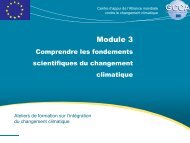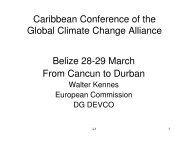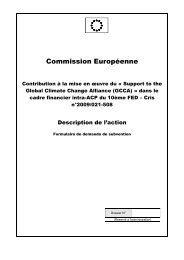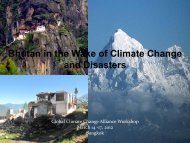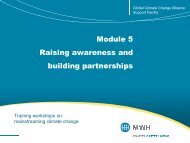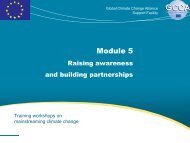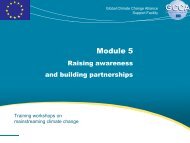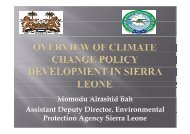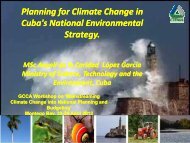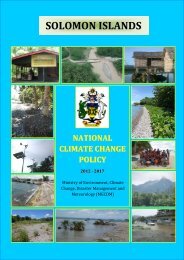Rwanda Green Growth Strategy 18nov11 - Global Climate Change ...
Rwanda Green Growth Strategy 18nov11 - Global Climate Change ...
Rwanda Green Growth Strategy 18nov11 - Global Climate Change ...
Create successful ePaper yourself
Turn your PDF publications into a flip-book with our unique Google optimized e-Paper software.
Chapter 2Recent studies in Kenya have shown that temperature rise would increase the optimum altitude forgrowing tea from between 1,500m and 2,100m AMSL to between 2,000m and 2,300m AMSL [12] . Coffeeand tea, <strong>Rwanda</strong>’s cash crops, are likely to require higher altitudes as temperatures increase, which mayreduce the amount of suitable land available due to differing soils and steeper slopes. It could also causeland use conflict as small-scale farmers of alternative crops, such as maize, cabbage, peas and passionfruit, compete for land with tea and coffee producers.<strong>Climate</strong> change could affect water security and food security, and as a result, could increase levels ofpoverty and force subsistence farmers into informal urban settlements. <strong>Rwanda</strong>’s energy security may be atrisk as hydropower contributes 50% of electricity, making it vulnerable to variation in rainfall andevaporation. Droughts reduce generating capacity of hydroelectric dams, and floods increase soil erosionand siltation which can damage dams. A good example of this is the drought in 2004 in <strong>Rwanda</strong> whichreduced hydropower capacity so much so that the government was forced to rent diesel power plants tomeet domestic demand. Regional planning is underway to complete four hydropower plants on the RusiziRiver to supply <strong>Rwanda</strong>, the Democratic Republic of Congo (DRC) and Burundi with 500MW ofhydropower. The power plants are being designed to use the maximum capacity of current river flows,which may be affected by climate change and therefore affect the capacity and efficiency of the plants.Chapter 2: <strong>Rwanda</strong>’s Development PathwayTourism, one of <strong>Rwanda</strong>’s largest earners of foreign exchange, is dependent on the survival ofgorillas in the Volcanoes National Park, and the preservation of the Nyungwe and Gishwati forests andAkagera National Park. These areas of natural beauty are biodiversity hotspots and are vulnerable tochange in temperature and rainfall which could reduce viable habitat and allow the spread disease. Thehealth of farm animals and humans is also at risk, particularly amongst those living below the poverty line,and as temperatures rise, diseases could spread to new areas, particularly higher altitudes. Out of the mainlivestock diseases in <strong>Rwanda</strong>, ticks (as ectoparasites), tick-borne diseases and trypanosomosis are themost likely to be sensitive to climate change [13] . There are seven vector-borne diseases (the most sensitiveto climate) in <strong>Rwanda</strong> that affect human health with malaria, tick bite fever and bilharzia or schistosomosismost likely to be affected by climate change. Human health would also be negatively impacted by naturaldisasters which can contribute to malnutrition, epidemics of diseases such as cholera.In order to safeguard biodiversity and ecosystems services; to ensure food, water and energysecurity; and to support future socio-economic development, <strong>Rwanda</strong> must adapt to the changing climateand become climate resilient.Oil PriceOil is expensive and continues to increase in value as demand exceeds supply and new resourcesbecome more difficult to extract. As oil reserves decline and additional costs are added to compensate forGHG emissions, oil prices are likely to increase. <strong>Rwanda</strong> imports all of its oil-based products used forenergy generation and transport, at a cost of USD210 million (2009 dollars) per year, which in 2008represented 4.7% of GDP. This heavy reliance on imported oil absorbs national finances that could bebetter spent on domestic energy which creates jobs and drives the local economy. It also puts <strong>Rwanda</strong> atrisk from oil price spikes. For example, the inflation spike from 5% to 20% in 2008 (Figure 8) was largelyattributable to the increasing global oil price. Inflation reduced to 2007 levels once the oil price crashed. TheInternational Energy Agency (IEA) estimates that a 10% increase of oil price reduces GDP of oil-importingcountries by 0.2% on average, though <strong>Rwanda</strong>’s economy would be more affected than most due to itshigh dependence on oil.National <strong>Strategy</strong> on <strong>Climate</strong> <strong>Change</strong> and Low Carbon Development 9




